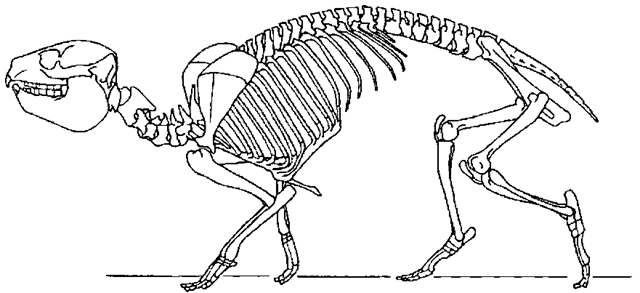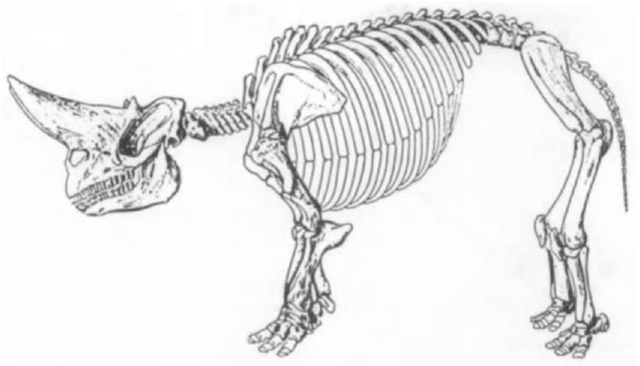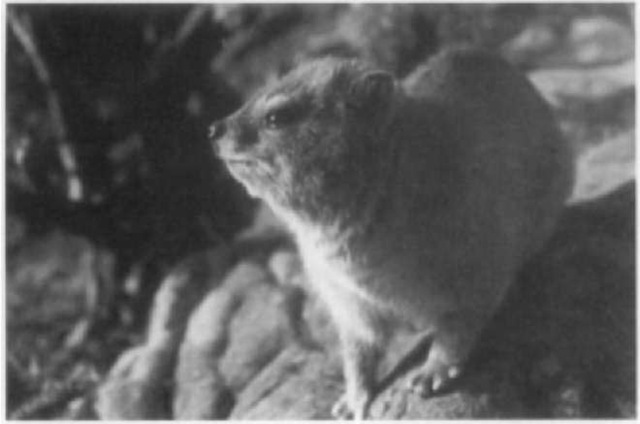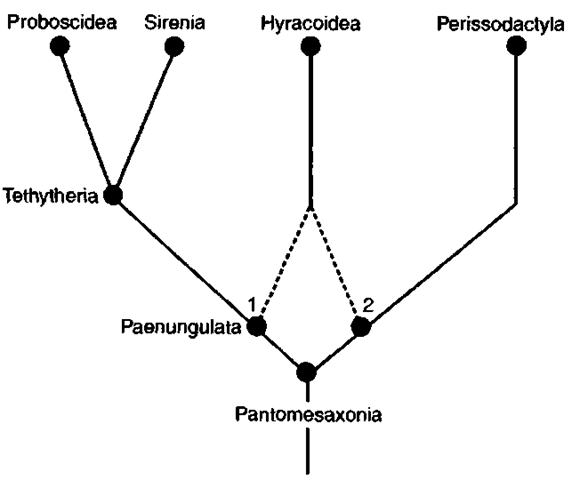The name Paenungulata, i.e., “near-ungulates,” was coined in 1945 by the American paleontologist George Gaylord Simpson to group seven orders of placental mammals in a major taxon ranked as a superorder. This grouping included three orders—Sirenia (sirenians or sea cows), Pro-boscidea (elephants), and Hyracoidea (hyraxes, also called “dassies”)—and four extinct orders—Pantodonta (pantodonts), Dinocerata (uintatheres), Pyrotheria (pyrotheres), and Em-brithopoda (arsinoitheres). It must be emphasized that Simpson included an extinct group in the Sirenia, the desmostylians, as suborder Desmostyliformes (in modem times usually considered an order, Desmostylia).
I. The Extant of Paenungulates
The contents and validity of the Paenungulata are controversial. Simpson himself acknowledged the fact that the superorder was “possibly polyphyletic.” Probably amphibious, they were not as specialized to aquatic life as sirenians. Proboscideans are terrestrial but may have had an aquatic origin and hyracoids are terrestrial and arboreal (Fig. 1). The extinct orders were terrestrial and nearly all were unfamiliar herbivorous animals already diverse in the early Tertiary. Pantodonts were largely distributed in America and Eurasia, the largest forms being no larger than a cow. Uintatheres were frequent in North America and Asia and reached the size of living rhinoceroses and superficially resemble them with strange paired horns on both the front and the back of the skull. Pyrotheres were restricted to the early Tertiary of South America and developed features paralleling the elephants: the incisors were in the shape of short tusks and the nasal openings were retracted, indicating the presence of a trunk. Arsinoitheres (Fig. 2), first described in Africa (in the early Oligocene of Egypt), were also present in Eurasia, although rare. They reached the size of living rhinos. They possessed a gigantic pair of horns on the nasal bones and a much smaller one on the frontal bones.
According to Simpson, the “nucleus” of the Paenungulata was the association of proboscideans, sirenians, hyracoids, and the extinct arsinoitheres. Today it can be said that the nucleus of the nucleus is the grouping of the proboscideans and sirenians, now called the Tethytheria. The relationship of the tethytheres to other mammalian orders is much debated and, as a consequence, the content of Paenungulata remains an enigma.
However, most modern authors agree that pantodonts, uintatheres, and pyrotheres are not related to elephants and sirenians and are therefore not paenungulates. This leaves the question: Are Proboscidea, Sirenia, Hyracoidea, and Ein-brithopoda monophyletic and should they be called collectively Paenungulata? When only extant species are considered, this question can be phrased as: Are hyracoids closely related to elephants and sirenians?
II. Hyracoids
The order Hyracoidea includes eight species (the exact number is still debated), classified into three genera: Procavia or rock hyrax (Fig. 3), Dendrohyrax or tree hyrax, and Hetero-htjrax or bush hyrax. They live in tropical and subtropical habitats of Africa. Heterohyrax is known in east Africa, and Dendrohyrax is distributed in central and western Africa. Procavia is largely distributed in Africa, but ranges north into Lebanon. Today hyracoids are small animals the size of a rabbit. Some fossil hyracoids were very large, such as tapir-sized Megalo-htjrax eocaenus found in the late Eocene and Oligocene of the Fayum area in Egypt or Pliohyrax graecus from the Miocene of Eurasia. The earliest fossil hyracoids are known from middle or lower Eocene sites from Algeria and associated large (Ti-tanohyrax) and small (Microhyrax) forms.
Extant hyracoids have feet with three toes. The third is the largest, and the first and fifth toe are absent. The hands have four fingers; the third is the largest, the fifth is reduced, and the first is lacking. The pattern of hands and feet is “serial,” meaning that the bones of the carpus and tarsus are stacked into separate columns. This is a derived condition compared to the generalized mammalian condition, which is alternate, where the bones of carpus and tarsus are stacked in overlapping rows, like bricks in a wall. Hyracoids also display a structure considered primitive for ungulates: the presence of a central bone located between the trapezoid and magnum. Aspects of the hyra-coid ankle are unique. A strong medial process (malleolus medialis) of the tibia articulates into a deep fossa situated on the astragalus medial to the main tibial articular facet. The astragalus has a flat distal articular surface for the navicular bone.
The gait is plantigrade. The sole of the foot has a soft elastic pad that allows cohesion on irregular substratum, such as trunks and branches. Sudorific glands keep the pad moist. The molars are lophodont. The first incisors are enlarged. The canines show an unusual shape: they are premolariform and nearly identical to the premolars so that canines were long understood as first premolars.
The cranium shows unique specializations, such as the pos-torbital bar (processus zygomaticus) made by both parietal and frontal bones. Also the hyoid apparatus is unique in the fact that the lingual process is formed by the hypohyal and not, as found elsewhere (i.e., perissodactyls and bovids), the basihyal.

Figure 1 Skeleton of the hyracoid Procavia capensis.

Figure 2 Skeleton of the embrithopod Arsinoitherium, Fayum, Egypt. Length: 3.50 tn.
Studies have shown that alleged primitive features, such as the plantigrady, were in fact derived secondarily. Ontogenetic development of the limbs shows that hyraxes are basic unguligrads.
III. Pantomesaxonian Interrelationships
Several authors classify extant perissodactyls, hyracoids, sirenians, and proboscideans in a clade called Pantomesaxo-nia (also named Altungulata). On the other hand, paenungu-late characters that support a sister group relationship between hyracoids and tethytheres come from placentation and fetal membrane development and from the locomotor apparatus. The peculiar structure of hyracoid fetal membranes is also known in tubulidentates (the aardvark) and could be associated to a more inclusive group. The serial arrangement of carpals and tarsals is a classical character uniting paenungu-lates. However, this condition is also known in nonpaenungu-late ungulates, such as Phenacodtis, a genus known from the late Paleocene up to the late Eocene, and usually considered related to Perissodactyla (living tapirs, rhinoceroses, and horses). Among tethytheres, desmostylians do not show a tax-eopod condition; hence a reversal is to be assumed for desmostylians. Other characters are clearly homoplastic, such as the amastoidy (lack of mastoid exposure on the cranium), which is also present in various taxa, such as rhinocerotids and pigs. The primitive condition is a reduced exposure (a possible pantomesaxonian character), which occurs in tapirs and in an extinct genus from the late Paleocene of China, Radinskya. The short face shared by living hyracoids and tethytheres is a homoplastic feature, as more primitive extinct hyracoids possessed a long face. On the other hand, different characters support sister group relationships between Hyra-coidea and Perissodactyla. These include a flat distal articular surface on the astragalus for the navicular; the hoof with mesial side with horned fused lamellae; the course of the sternoscapularis muscle. The presence of an eustachian sac— a pharyngeal dilatation of the eustachian tube—has also been cited as a synapomorphy for hyracoids and perissodactyls. It is known in hyracoids, tapirs, and horses, but the black rhino Diceros bicornis lacks it. The eustachian sac changes the course of the internal carotid artery by pushing it away from the tympanic area of the osseous bulla. Because the course of the internal carotid is extrabullar in Diceros, this position is perhaps a reversal, an indication of a former possession of the eustachian sac in rhinocerotids. These characters support monophyly of hyracoids and perissodactyls and refute the monophyly of paenungulates. However, no molecular data support a sister group relationship between hyracoids and perissodactyls. On the contrary, various molecular analyses bring hyracoids closer to tethytheres with different exact topologies: sister group of tethytheres, or closer to sirenians, or closer to proboscideans.

Figure 3 The rock hyrax Procavia capensis in its type area (Table Mountain, Cape Town, South Africa).
In conclusion, although many morphological classifications and phylogenies suggest monophyly of pantomesaxonians, the question of monophyly or paraphyly of paenungulates is still not satisfactorily resolved (Fig. 4). As a matter of fact, the recent classification of Mammalia by McKenna and Bell (1997) proposes a new name for extant elephants, sirenians, and hyracoids, i.e., for the nucleus of paenungulates sensu Simpson; the Uranotheria, introduced as an order made of three suborders: Hyracoidea, Tethytheria, and extinct Embrithopoda.

Figure 4 Interrelationships of pantomesaxonians. If Hyracoidea is related to Perissodactyla (hypothesis 2) and not to Tethytheria (hypothesis 1), the Paenungulata (Proboscidea, Sirenia, and Hyracoidea) becomes paraphyletie.
